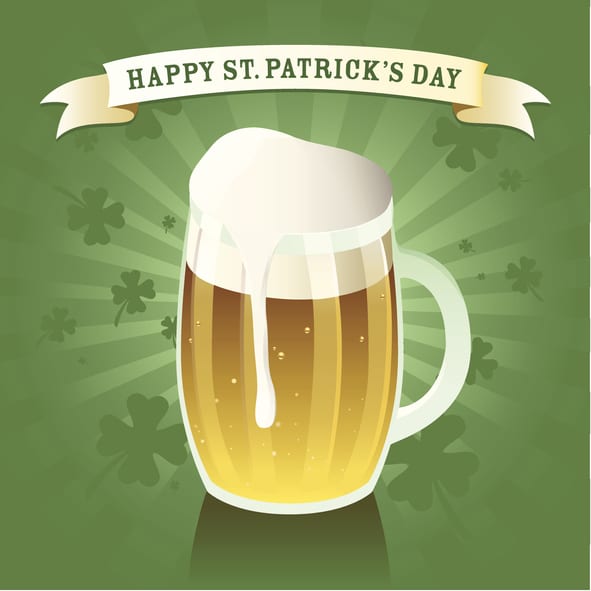Welcome to the next justification to party! Cinco de Mayo, Fourth of July, New Year’s Eve, my birthday, the Cubs winning the pennant…. all wonderful reasons to throw one or two or a dozen drinks down to celebrate. Heck, since we are picking days, add TGIF, add Monday night football and don’t forget Wine Wednesdays. How about weddings, bar mitzvahs, and just the fact I’m getting off work today?!? But maybe, just maybe, the king of them all: St. Patrick’s Day!
St. Patrick’s Day, or the Feast of Saint Patrick, is a cultural and religious celebration held on March 17th, the traditional date of Saint Patrick’s death, the foremost patron saint of Ireland. And obviously a wonder explanation as to why it’s OK to drink enough Irish whiskey and green beer that we completely forget poor ole Saint Patrick and his noble efforts!
Pavlovian Conditioning
But why? Why do we create these mental connections and associations? Why have we hard-wired the connection between drinking and St Patrick’s Day. And this applies to all connections we’ve built regarding alcohol consumption, binge drinking or even just a glass of wine after work. It brings to mind a social experiment conducted by Ivan Pavlov, also termed Pavlovian Conditioning.
In the experiment (and I’m paraphrasing), Pavlov was able to measure the release of saliva in a group of dogs he was monitoring. Obviously, when the dogs were fed, saliva was produced. But Pavlov added the ringing of a bell during the feeding of the dogs. The dogs were conditioned to associate the ringing of the bell to their feeding. At a point in the experiment, Pavlov merely rang the bell, without feeding them, and guess what? The dogs salivated. How could the seemingly benign sound of a bell cause a dog to salivate? The dogs had become conditioned to associate the two stimuli as related: bell and food. Some may call this “training” or the dogs intelligence. But regardless, it a very salient point in the world of addiction and recovery. We can ask ourselves: “What normally benign activities have we learned to associate to alcohol consumption that we literally “salivate” just thinking about them?”
Celebrations and binge drinking
We don’t have the bandwidth in this article to discuss all the social conditioning we have about alcohol. We have been conditioned through our family systems, multimedia mechanisms (TV, radio, social media marketing) and almost anything our senses can perceive. Someone suffering from alcohol use disorders has certainly thousands of associations that are linked to alcohol use, but let’s look at celebrations in isolation:
- Champagne bubbles for New Year’s Eve.
- Irish Pubs on St Patrick’s Day.
- Margaritas on Cinco de Mayo.
- Graduation parties!
- Fireworks, BBQ and beer on 4th of July.
- Family drunk fests on Thanksgiving.
- Oh Lord…. the company Christmas party!!
- Miller time! Just for finishing a hard day at work.
To acknowledge these association have been conditioned into our hard-wired brain is one thing; but to remedy them for our own recovery is another. We will address rewiring after we consider the dangers of binge drinking.
Binge Drinking and Blood Alcohol Content (BAC)
So, as you do one more round of “Oh Danny Boy” and a shot of the best Irish Whiskey $5 happy hour can provide, let’s dull your buzz with facts about alcohol poisoning.
Alcohol requires no digestion and is metabolized before many other nutrients. About 20% of the alcohol you drink passes through the stomach wall and can reach the brain within one minute. The remaining 80% passes through the small intestine before entering the bloodstream. As alcohol enters the bloodstream, the measurement of Blood Alcohol Content (BAC) increases.
BAC Level Physical & Mental Effects
.01-.03 No apparent effect. Slight mood elevation
.04-.06 Relaxation and warm feelings. Minor behavior impairments.
.07-.09 Balance, speech vision and control are impaired.
.10-.15 Significant to gross impairment of motor control. Speech will probably be slurred. Blurred vision and loss of balance.
.16-.20 Nausea may occur. Dysphoria or unease is dominant. Potential for anxiety. Difficulty walking and mental confusion.
.21-.30 Severe intoxication: Likely to have alcohol poisoning!
.30 and above Loss of consciousness, onset of coma, potential death.
The primary factors determining BAC are the number and time period over which alcoholic drinks are consumed. However, other factors contribute to BAC levels such as: body weight and composition, biological sex, medications and food consumption.
Now we all know, there’s a certain perception of bravado to drinking so much you become the life of the party or fight the biggest guy in the room, again maladaptive social conditioning. But let’s consider the long-term effects of this behavior are life threatening and treatment is a life saving measure.
Rewiring and Un-conditioning
If you have found yourself a victim to social conditioning and recognize the risks of binge drinking (up to and including literally poisoning yourself), congratulations, you have taken the vital first step. Awareness!
The first few steps to any treatment involve admission of the problem, surrender and acknowledging a solution exists. Acknowledging we have linked alcohol use to certain events, celebrations and holidays lets us become aware that an unwinding is necessary. And as difficult as it may initially seem, the process on re-conditioning is the same as the original conditioning. With guidance, it is possible to build new hard-wired associations to prosocial, positive activities. With awareness and intention, we can learn new behaviors and rituals that do not involve alcohol, while maintaining the original desire to celebrate.
Conclusion
We can, indeed, seek treatment and with the guidance of counseling and a support team learn how to connect new activities to holidays that do not involve hangovers, hurting loved ones or handcuffs! At Pinelands, various treatment options exist to help you begin your journey towards recovery. Please reach out today!
